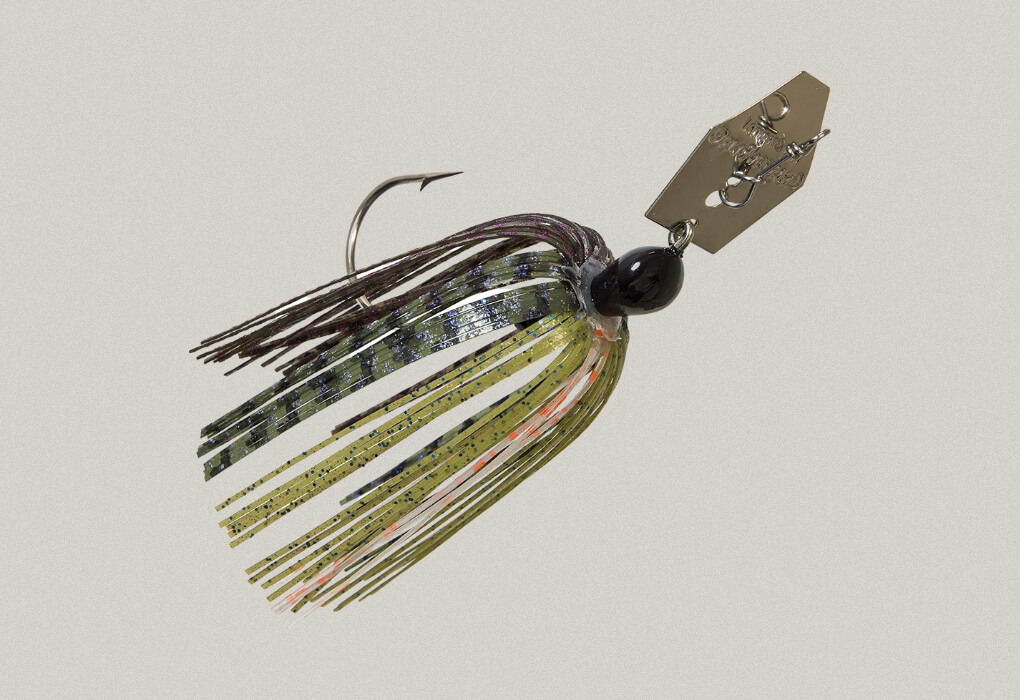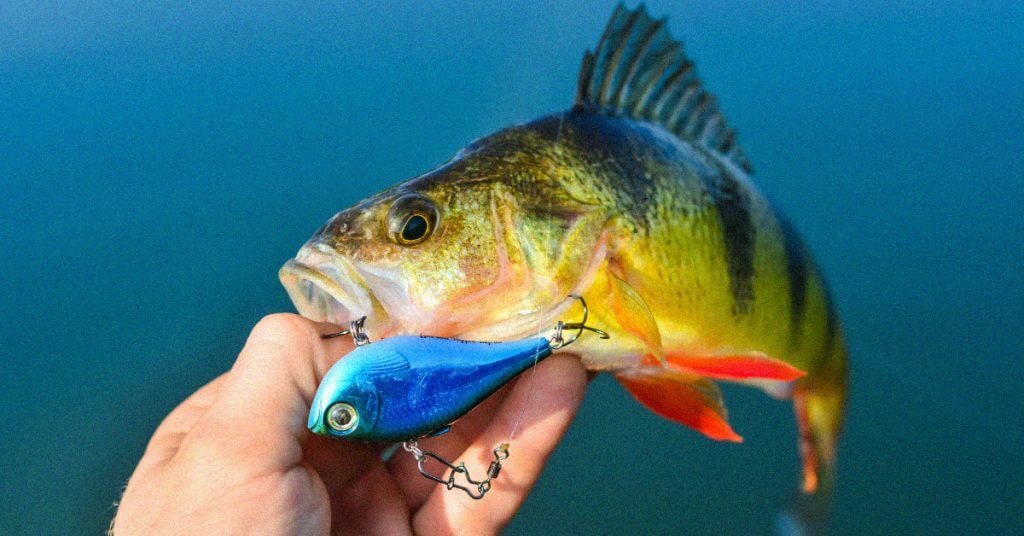Growing up, I mostly fished muddy ponds. I noticed some colors and lures worked better than others.
This intrigued me, and I decided to research further to discover why this was the case.
In college, I learned about how fish see and use their lateral line (we’ll discuss this more later), and after speaking with professional anglers, my suspicions were confirmed.
The best lure color for muddy water was the extremes, a bright color such as chartreuse or dark colors such as black and blue.
Knowing why these colors work in muddy and stained water has made me a much better angler, and instead of making you learn it through years of trial and error, I’ll give everything away below!
Anglers.com Community Coordinator Wesley Littlefield explains why these colors work in muddy water in this YouTube video.
The Best Lure Color for Muddy Water
As I mentioned above, the opposite colors work best in muddy water.
Bright colors tend to stand out and catch a bass’s eye in murky water, while dark colors create a better silhouette for the bass to see.
Keep the following muddy water bass fishing tips in mind to know what color bait to use for bass.
Bright Colors

Less natural colors such as chartreuse, firetiger, and neon orange help your lure stand out in the dirty water because they create a contrast, unlike natural colors intended to blend in with the habitat.
If you’ve ever played hide-and-seek at night, you know not to wear a brightly colored shirt because the seeker quickly sees you.
The concept is the same in muddy water because less light can get through the water.
Using a mixture of these colors also helps. I have a white swimbait with chartreuse mixed in for a mix of natural and bright bait colors. I also love throwing a white or firetiger crankbait.
I also mix these bright colors when fishing soft plastics.
One of my favorite shaky head worms is a green pumpkin with a chartreuse-tipped tail.
During the spawn, many anglers throw a bright pink worm to trigger bites.
Colorful fishing lure colors work well in the shallows but fall short of dark colors as the depth increases. So if there is virtually no visibility, I’d recommend skipping the bright colors and using the blacks and blues.
Try a couple of different brightly colored green lures next time you’re fishing murky water to get more bites!
Dark Colors

On the other end of the spectrum are dark-colored lures. Typically black and blue or purple.
Dark colors work well because they create a better silhouette than natural colors.
This is where my hide-and-seek analogy doesn’t work well; however, when you think of a silhouette, it’s usually a black figure in front of a light background.
This is the case when fishing, the muddy water is a lighter color than your dark-colored lure, which makes it stand out like a silhouette.
How Fish “See” in Muddy Water
Of course, fish use their eyes to see. However, that’s not the only sense they rely on to find their prey.
They also use their lateral line located along their head and body.
By using all their senses, bass can be efficient predators, even in murky conditions.
The Color Spectrum in the Water Explained

Clear water often appears blue because blue is the last color to be absorbed by water. Muddy water is obviously not blue because of the sediment mixed into the water.
The suspended dirt blocks the light from penetrating as far as it does in clear water.
Red is the first color to be absorbed by water, followed by orange, yellow, and green because they are shorter wavelengths.
Colors of longer wavelengths, such as blue and violet, are absorbed last.
This means darker colors can be seen at deeper depths or in dirtier conditions.
So the best baits for dirty water will be colored purple, blue, or black because those colors can be fished throughout the water column.
Lateral Line: This Feels Fishy
The lateral line is what fish use to detect movements and pressure changes in the surrounding water.
This is why it’s important to use lures with lots of movement and vibration when the water is dirty.
The vibrations the lure gives off allow the fish to hone in on the lure’s location without it having to see it clearly.
That leads to the question, which lures are best for muddy water conditions?
The Best Lure for Muddy Water
Water clarity should influence which lures you choose to use to catch bass. Subtle lures and finesse techniques won’t work as well as moving baits in dark water because fish can’t see as well as they can in clear water.
Moving lures that have a lot of vibration, are noisy, or create a commotion on top of the water are the best lures for murky water.
Below, I’ll break down a few of my go-to muddy water fishing lures.
Moving Lures
Despite subtle fishing lures such as a swim jig, jerkbait, and swimbaits, they create enough disturbance in the water that bass can find using their lateral line and see the lure move once they’re close enough.
When you rig a swim jig or a Texas rig, use a trailer or soft plastic that moves a lot in the water. This will help bass find your bait better in muddy water.
Vibrating Lures

Moving lures like a spinnerbait, vibrating jig, or squarebill crankbait all cause a vibration as they move through the water. Bass can hone in on these vibrations using their lateral line in murky water.
Spinnerbaits come with different blades depending on your situation. Willow blades create less vibration than Colorado blades. Therefore, Colorado blades are the better option when the water clarity is poor.
Noisy Lures
Crankbaits and jigs sometimes have rattles to create noise that imitates baitfish and crawfish.
Some crankbaits like the Livingston Lures Howeller DMC have a natural crawfish sound that activates when the lure hits the water and turns off once it’s dry.
A chatterbait not only has a vibration, but some are also designed so that the blade hits against the jig head, creating a clicking sound.
The additional sounds not only help the fishing lures appear more natural but also help bass find them in muddy waters.
Topwater Lures
Topwater lures like buzzbaits, Whopper Ploppers, frogs, and spooks all create a commotion at the water’s surface that grabs a bass’s attention, which makes them excellent muddy water bass fishing lures.
The commotion caused by these lures allows the bass to use its lateral line and its eyes to find your bait.
These are some of the best lures for muddy water; however, if you ask 10 anglers what the best muddy water bass fishing lures are, you’ll get 12 different answers!
That’s why I prefer to keep it simple when murky water fishing.
Frequently Asked Questions
Below you’ll find answers to commonly asked questions about which color is best in muddy or murky water.
What colors do bass see in murky water?
The colors that bass see in murky water best are blacks, blues, chartreuse, or bright green.
Bass can see their prey like shad and bluegill in murky water, but they rely on their lateral line more than their eyesight.
What do you fish with in muddy water?
When fishing in muddy water, I recommend fishing with baits that cause a lot of disturbance or brightly colored moving lures.
What color jig do you use in muddy water?
The best color jig to use in muddy water is a black and blue jig. Adding a trailer with a lot of movement also helps.
Last Cast
While there is no single best lure color for muddy water, it’s safe to say that bright and dark colors are the best options because they stand out the most, making it easier for bass to find your lure.
Using moving lures that bass can use their lateral line to find is another way to get big bass to bite in murky water conditions.
I’d love to hear what your favorite muddy water lure to throw is, don’t forget to tell me which color!




